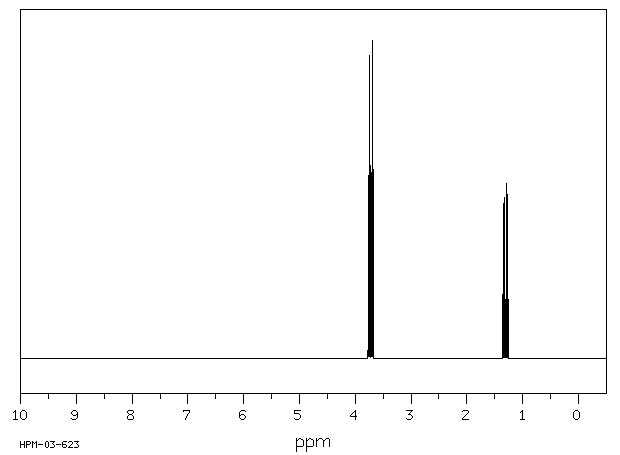silylphosphine | 159430-30-5
分子结构分类
中文名称
——
中文别名
——
英文名称
silylphosphine
英文别名
silylphosphane
CAS
159430-30-5
化学式
H5PSi
mdl
——
分子量
64.099
InChiKey
SMOJNZMNQIIIPK-UHFFFAOYSA-N
BEILSTEIN
——
EINECS
——
-
物化性质
-
计算性质
-
ADMET
-
安全信息
-
SDS
-
制备方法与用途
-
上下游信息
-
文献信息
-
表征谱图
-
同类化合物
-
相关功能分类
-
相关结构分类
计算性质
-
辛醇/水分配系数(LogP):-0.86
-
重原子数:2
-
可旋转键数:0
-
环数:0.0
-
sp3杂化的碳原子比例:0.0
-
拓扑面积:0
-
氢给体数:0
-
氢受体数:0
反应信息
-
作为反应物:描述:silylphosphine 在 ammonia or alcohol 作用下, 以 not given 为溶剂, 生成 phosphan参考文献:名称:Fritz, G.; Berkenhoff, H. O., Zeitschrift fur Anorganische und Allgemeine Chemie摘要:DOI:
-
作为产物:描述:硅烷 、 phosphan 以 neat (no solvent) 为溶剂, 生成 silylphosphine参考文献:名称:Fritz, G., Zeitschrift fur Anorganische und Allgemeine Chemie摘要:DOI:
-
作为试剂:参考文献:名称:Demuth,R.; Grobe,J., Zeitschrift fur Naturforschung, Teil B: Anorganische Chemie, Organische Chemie, 1973, vol. 28, p. 219 - 220摘要:DOI:
文献信息
-
Preparation and spectroscopic studies of some reactions of lithium derivatives of silanol, disilylphosphine, and related compounds作者:Stephen Cradock、E. A. V. Ebsworth、David W. H. Rankin、W. John SavageDOI:10.1039/dt9760001661日期:——reacts with Y(SiH3)2(Y = O, S, or Se) or Z(SiH3)3(Z = P or As) in diethyl ether to give Li(YSiH3) or Li[Z(SiH3)2]; these compounds have been characterised by i.r., Raman, and n.m.r. spectroscopy, and some of their reactionswith halides have been studied. Trisilylamine does not react cleanly with LiMe to form an analogous compound. The n.m.r. spectra of solutions containing both Li(YSiH3) and Y(SiH3)2
-
Silyl and germyl complexes of platinum and palladium. Part 4. Reactions between four-co-ordinated halogenohydridobis(triethylphosphine)platinum(II) complexes and silyl-amines or -phosphines作者:E. A. V. Ebsworth、Joyce M. Edward、David W. H. RankinDOI:10.1039/dt9760001673日期:——Reactions between NH(SiH3)2 and trans-[PtH(I)(PEt3)2] give trans-[PtI(PEt3)2(H2SiNHSiH3)] and trans-[PtI(PEt3)2(SiH2)}2NH]; with N(SiH3)3, only trans-[PtI(PEt3)2H2SiN(SiH3)2}] is formed, probably for steric reasons. With PH2(SiH3) or PH(SiH3)2, PH3 and trans-[PtI(PEt3)2(SiH3)] are produced; P(SiH3)3 reacts with a four-fold excess of trans-[PtH(I)(PEt3)2] to give PH3 and trans-[PtI(PEt3)2(SiH3)],NH(SiH 3)2和反式-[PTH(I)(PEt 3)2 ]之间的反应得到反式-[PTI(PEt 3)2(H 2 SiNHSiH 3)]和反式-[PTI(PEt 3)2(SiH 2)} 2 NH];对于N(SiH 3)3,仅出于反位原因,仅形成反式-[PTI(PEt 3)2 H 2 SiN(SiH 3)2 }]。有PH 2生成(SiH 3)或PH(SiH 3)2,PH 3和反式-[PTI(PEt 3)2(SiH 3)];P(SiH 3)3与过量四倍的反式-[PTH(I)(PEt 3)2 ]反应生成PH 3和反式-[PTI(PEt 3)2(SiH 3)],但反应比率为1:1至2:1(膦:PT),产物为反式-[PTI(PEt 3)2 H 2SiP的硅烷(SiH 3)2 }]和反式- [PTI(PET 3)2(的SiH 2 } 2 PSiH 3 ]此系列的唯一甲硅烷基化合物,得到具有可识别的种类。反式-
-
Gmelin Handbuch der Anorganischen Chemie, Gmelin Handbook: F: PerFHalOrg.3, 1.2, page 14 - 30作者:DOI:——日期:——
-
Gmelin Handbuch der Anorganischen Chemie, Gmelin Handbook: F: PerFHalOrg.3, 1.9, page 70 - 123作者:DOI:——日期:——
-
The infrared laser photochemistry of silane作者:F.W. LampeDOI:10.1016/0584-8539(87)80099-5日期:1987.1
表征谱图
-
氢谱1HNMR
-
质谱MS
-
碳谱13CNMR
-
红外IR
-
拉曼Raman
-
峰位数据
-
峰位匹配
-
表征信息
同类化合物
黑色氧化镍
陶土,高岭土
镧硒化物
镧四氧代钛(4:3)
镥磷化物
镍化钛
锶亚碲酸盐
锗酰亚胺
锗烷
锆酸钆
锂硼氢
铽三钒九氧化物
铷,加合(1:1)氙
银(1+)甲烷
铵羟基(氧代)二氧化铬
铵对钨酸盐六水合物
铬铁氧化物
铬酸锂(二水)
铬酸钾锌盐
铬酸钠
铬酸钠
铬酸盐(VI)离子
铬酸二钠盐十水合物
铬酸
铬[51Cr]酸钠
铝矾土
铜铵络合物
铜铟硒化物
铌酸锂
铌酸铯
铌
铈钛氧化物
铈硒化物
铅酸钠
铁酸钾22
铁酸钾10
钾硼氢
钽酸钠
钼酸酯(Mo7O246-)(9CI)
钬钒四氧化物
钡,加合(1:1)氦
钠亚铬酸盐
钛酸铪
钛酸铈
钛酸钆
钒酸镍
钒酸锆
钒酸锂
钒酸铽
钒酸钙







